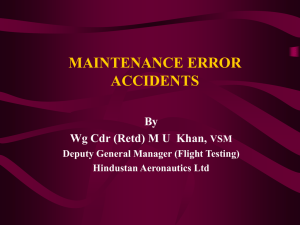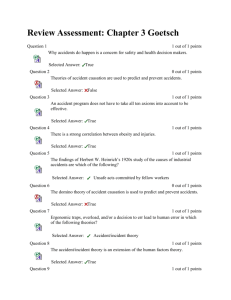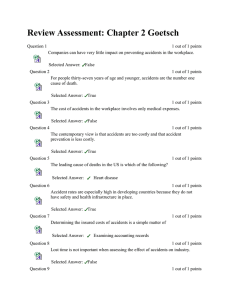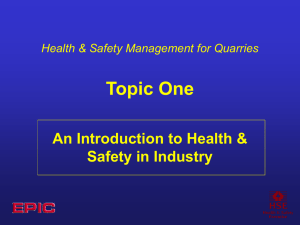Top 3 - Flight Safety Foundation
advertisement
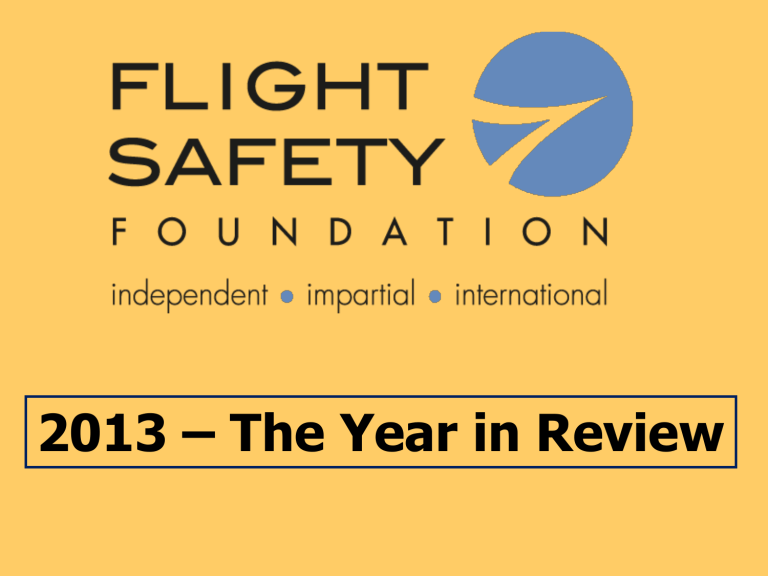
2013 – The Year in Review 1 The Fleets - 2013 Type Western Built Eastern Built Turbojets Turboprops Total 22,113 1,007 23,120 4,797 1,001 5,898 Business Jets Source: Ascend - A Flight Global Advisory Service 18,072 Accident Classifications Aircraft * Type: Turbojets, Turboprops, Piston, Helicopters * Size: Weight, number of seats * Use: Passenger, cargo, business, government * Western built or Eastern built How Measured * Per hours flown * Per departures * Per number of aircraft Classification * Hull Loss Accident * Total Loss Accident * Economic Loss Accident * Substantial Damage Accident * Fatal Accident * Major Accident Accident Classifications Major Accident: An accident in which any of three conditions is met: 1. Aircraft destroyed, or 2. Multiple fatalities to occupants, or 3. One fatality and aircraft substantially damaged Major Accidents CFIT LOC Excursion Commercial Jets 1 January 2013 to 31 December 2013 Date Operator Aircraft Location Phase Fatal Almaty, Kazakhstan Approach 21 Approach 0 29 January SCAT Air CRJ-200 13 April Lion Air B-737 Bali, Indonesia 29 April National Airlines B-747 Bagram, Afghanistan Takeoff 7 6 July Asiana Airlines B-777 San Francisco, USA Landing 3 14 August UPS A-300 Birmingham, AL, USA Approach 2 17 November Tatarstan Airlines B-737 Kazan, Russia Approach 50 Source: Ascend - A Flight Global Advisory Service Commercial Jet Major Accidents 2000 through 2013 20 19 15 16 13 19 19 13 17 17 14 13 10 11 5 7 2001 02 Eastern Built 03 04 05 06 07 08 09 10 11 7 12 13 Major Accidents Commercial Jets 1 January 2014 to 16 April 2014 Date 8 March Operator Aircraft Malaysian Airlines B-777 Source: Ascend - A Flight Global Advisory Service Location Indian Ocean CFIT LOC Excursion Phase Fatal Enroute 239 Source: Ascend - A Flight Global Advisory Service Major Accidents CFIT Commercial Turboprops (> 14 seats) 1 January 2013 to 31 December 2013 Date Operator Aircraft Location Phase Fatal Enroute 3 23 Januray Kenn Borek Air DHC-6 Terra Nova Bay, Antarctia 13 February South Airlines AN-24 Donetsk, Ukraine Approach 5 4 March CAA Fokker 50 Goma, DRC Approach 7 8 March ACE Air Cargo Beech 1900 Anchorage, Alaska, USA Approach 2 7 April Sahel Air Service Beech 1900 San Tome and Principe Approach 1 17 April Lao Air DHC-6 Vientiane-Wattay, Laos Takeoff 0 16 May Nepal Airlines DHC-6 Jomson, Nepal Landing 0 16 May Flying Dragon Aviation Y-12 Shenyang, China Climb 0 1 June Sita Air DO-228 Simikot, Nepal Landing 0 10 June Merpati Airlines MA-60 Kupang, Indonesia Landing 0 13 June SkyBahamas SAAB 340 Marsh Harbor, Bahamas Landing 0 29 June Batair Cargo EMB-110 Francistown, Botswana Approach 2 9 August Ukraine Air Alliance AN-12 Leipzig, Germany Start 0 9 Sept CorpFlite DO-228 Vina Del Mar, Chile Approach 2 Major Accidents Commercial Turboprops (> 14 seats) 1 January 2013 to 31 December 2013 (cont.) Date Operator Aircraft Location CFIT Phase Fatal 10 October MASwings DHC-6 Kudat, Malaysia Landing 2 16 October Lao Airlines ATR-72 Pakse, Laos Approach 49 19 October Air Niugini ATR-42 Madang, Papua New Guinea Takeoff 0 3 November Aerocon Metro III Riberalta, Bolovia Approach 8 10 November Bearskin Airlines Metro III Red Lake, Canada Approach 5 2 December IBC Airways Metro III Arecibo, Puerto Rico Enroute 2 26 December Irkut AN-12 Irkutsk, Russia Approach 9 Source: Ascend - A Flight Global Advisory Service Commercial Turboprop Major Accidents 2000 through 2013 40 39 35 30 31 33 31 26.1 (12 years) 25 20 29 24 24 22 15 21 20 23 22 17 10 5 2001 02 03 04 05 06 07 08 Eastern Built 09 10 11 12 13 20.6 (5 years) Source: Ascend - A Flight Global Advisory Service Major Accidents CFIT Commercial Turboprops (> 14 seats) 1 January 2014 to 16 April 2014 Date Operator Aircraft Location Phase Fatal Approach 0 20 January ------------------- AN-28 Addis ababa, Ethiopia 16 February Nepal Airlines DHC-6 Khidim, Nepal Enroute 18 17 February 748 Air Services HS-748 Rubkona, S. Sudan Landing 1 21 February Libyan Air Cargo AN-26 Grombalia, Tunisia Approach 11 13 Major Accidents Business Jets 1 January 2012 to 31 December 2012 Date Operator Aircraft Phase Fatal Pueblo, CO, USA Takeoff 0 2 February Extrapoint, LLC 12 February Trident Aviation Svcs Gulfstream IV Bakavu-Kavumu, DRC Landing 3 1 March Asia Today, Ltd Citation 750 Egelsbach, Germany Approach 5 15 March Private Citation 501 Franklin-Macon, NC, USA Landing 5 18 June Triple C Devlopment Beech 400 Atlanta,Gegoria, USA Landing 0 13 July Universal Jet Aviation Gulfstream IV Le Castellet, France Landing 3 2 August Airnor Citation 500 Santiago de Compostela, Spain Approach 2 15 Sept Private Lear 24 Bornholm, Denmark Approach 0 18 Sept Dewberry Air LLC Beech 400 Macon, GA, USA Landing 0 11 Nov Tropic Air Taxi Aero Citation 525 Sao Paulo, Brazil Landing 0 17 Nov US Customs Citation 550 Greenwood SC, USA Landing 0 9 December Starwood Management Iturbie, Mexico Enroute 7 Oklahoma City, USA Landing 0 21 December US Customs Lear 35 Location Lear 25 Citation 550 Source: Ascend - A Flight Global Advisory Service Major Accidents Business Jets 1 January 2013 to 31 December 2013 Date Operator Aircraft 20 February The Vein Guys Premier I 4 March Global Jet Luxembourg 17 March 7700 Enterprises 5 May Private 29 September CREW MMCLLC 18 October Dufrense, Inc 19 November AirEvac International Phase Fatal Thomson, GA, USA Landing 5 Premier I Annemasse, France Takeoff 2 Premier I South Bend, IA, USA Approach 2 Lear 60 Valencia, Venezuela Approach 2 Citation Jet CJ2 Santa Monia, CA, USA Landing 4 Citation I Derby, Kansas, USA Climb 2 Lear 35 Ft. Lauderdale, USA Climb 4 Approach 2 17 December Mallen Industries Source: Ascend - A Flight Global Advisory Service Premier I Location Atlanta, GA, USA Business Jet Major Accidents 2000 through 2013 20 15 14 15 14 10.4 Average 10 8 9 8 12 13 11 8 7 5 2001 02 03 04 05 06 07 08 09 10 7 8 11 12 13 Business Jet Major Accident Rate 2000 through 2013 (Accidents per 1,000 Aircraft) 1.0 .75 5 Year Average: .49 .50 .25 2005 06 07 08 09 10 11 12 13 Major Accidents Business Jets 1 January 2014 to 16 April 2014 Date Operator Aircraft Location Phase Fatal 5 January Private Challenger 601 Aspen, CO, USA Landing 1 12 January Private Citation Trier, Germany Apporach 4 3 March Iran CAA Falcon 20 Kish Island, Iran Unk 4 Source: Ascend - A Flight Global Advisory Service Approach and Landing Major Accidents Commercial Jets 1 January 2013 through 31 December 2013 Date Operator Aircraft Location Phase Fatal Almaty, Kazakhstan Approach 21 Approach 0 29 January SCAT Air CRJ-200 13 April Lion Air B-737 Bali, Indonesia 6 July Asiana Airlines B-777 San Francisco, USA Landing 2 14 August UPS A-300 Birmingham, AL, USA Approach 2 17 November Tatarstan Airlines B-737 Kazan, Russia Approach 50 Business Jet Major Accidents 2000 through 2012 20 63% of Business Jet Major Accidents were Approach and Landing Accidents ALA Accidents 15 14 15 14 13 10 8 5 8 6 8 9 5 8 9 8 7 12 8 7 7 6 5 4 2000 01 02 10.5 11 03 04 05 06 07 08 5 09 10 11 8 7 4 5 11 12 13 6.5 Controlled Flight into Terrain Major Accidents Commercial Jets 1 January 2013 to 31 December 2013 Date Operator Aircraft Location Phase Fatal Almaty, Kazakhstan Approach 21 Approach 0 29 January SCAT Air CRJ-200 13 April Lion Air B-737 Bali, Indonesia 6 July Asiana Airlines B-777 San Francisco, USA Landing 3 14 August UPS A-300 Birmingham, AL, USA Approach 2 Sources: Honeywell (Don Bateman), Ascend 5 Year Running Average 23 Aircraft Upset Major Accidents Commercial Jets 1 January 2013 through 31 December 2013 Date Operator Aircraft Location 29 April National Airlines B-747 Bagram, Afghanistan 17 November Tatarstan Airlines B-737 Kazan, Russia Phase Fatal Takeoff 7 Approach 50 Aircraft Upset Major Accidents Commercial Jets 1999 through 2013 Number of Accidents 0 0 0 0 6 0 4 0 0 0 1999 2000 2001 2002 2003 2004 2005 2006 2007 2008 2009 2010 2011 2012 2013 Being Predictive In A Reactive World 26 Being Predictive • • Can we be predictive ? Will it be successful in reducing risk ? Safety Basics Safety = Risk Management * Eliminate risk * Reduce risk * Acknowledge risk Managing Risk Risk Management 101 • Risk = (Probability) X (Severity) • Everything in life has risk • Manage Risk by modifying P or S The Key to Risk Management #1 Identify Hazards Being Efficient Good: Prevent 1 accident in 5 years Better: Prevent 5 accidents in 1 year Fatalities by CAST/ICAO Common Taxonomy Team (CICTT) Aviation Occurrence Categories Fatal Accidents – Worldwide Commercial Jet Fleet – 2003 Through 2012 Reactive: Tending to react, characterized by reaction Proactive: Preparing for, intervening in, or controlling an expected occurrence or situation Predictive: Inference regarding a future event based on probability The Spectrum of Safety Fly-crash-fix-fly Identify hazards as they appear in accidents Reactive Study past accidents and incidents to identify hazards and reduce risk Utilize data from incidents and normal operations to identify trends and reduce risk before an accident happens Proactive Predictive Single Accident Data----------Consolidated Accident/Incident Data ------Accident/Incident/Operational Data Data Availability/Utilization Predicting • We can easily predict 90% of next year’s accidents - > 50% will be approach and landing - Half of those will be runway excursions - There will be at least 2 Jet and 4 Turboprop CFIT accidents - There will be 1 or 2 upset aircraft Predicting “Black swan” events - TWA-800 BA-038 - QF-32 - Being Predictive • Can we be predictive ? Being Predictive • Can we be predictive ? YES Fatalities by CAST/ICAO Common Taxonomy Team (CICTT) Aviation Occurrence Categories Fatal Accidents – Worldwide Commercial Jet Fleet – 2003 Through 2012 Safety Fatality Data - Circa 1992 Collision with terrain Approach and landing Loss of control Maintenance ATC systems Postcrash survival Inflight fire/smoke Engine failures Airport ground control Nonconfiguration takeoffs Windshear Deicing/anti-icing Rejected takeoff 0 500 1000 1500 2000 2500 3000 Trending • Can detect trends and future hazards * Systems * Locations * Procedures ASAP and FOQA Analysis of OAK Arrivals Receiving TAWS Alerts TCAS Hotspot Snap Shot Being Predictive • Will it be successful in reducing risk ? Predictive Challenge - Being able to get the support of the decision makers Keys to Predictive Success 1. Data and the technology to use the data to make the risk management case 2. Decision maker support Keys to Predictive Success A Change of Paradigm Outcome Based Event Based Outcome Based vs Event Based 583 Fatalities Since 1995 (19 years): Average 1.0 a year 165 Fatalities 1977 0 Fatalities Since 1995 (19 years): Average 40.0 a year 1,121 Fatalities 2005 The Spectrum of Safety Fly-crash-fix-fly Identify hazards as they appear in accidents Study past accidents and incidents to identify hazards and reduce risk Reactive Utilize data from incidents and normal operations to identify trends and reduce risk before an accident happens Proactive Predictive Single Accident Data----------Consolidated Accident/Incident Data ------Accident/Incident/Operational Data Data Availability/Utilization Negative Outcome Negative Outcome(s) Events Challenges to being successful in predicting • Data X • Technology to utilize data X • Support of a reactive system TBA 2013 Summary Aviation Safety 2013 Commercial jets had another great year Turboprops had an average year Business jets had a better than average year CFIT has returned as the leading killer We now have the capability to be predictive in our safety efforts – but is the system ready to take advantage of this capability ? Making Aviation Safer by reducing the Risk of an Accident


